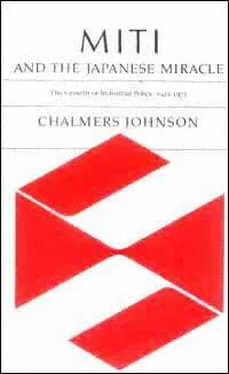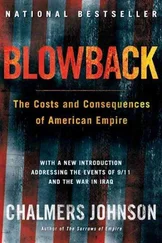Chalmers Johnson - MITI and the Japanese miracle
Здесь есть возможность читать онлайн «Chalmers Johnson - MITI and the Japanese miracle» весь текст электронной книги совершенно бесплатно (целиком полную версию без сокращений). В некоторых случаях можно слушать аудио, скачать через торрент в формате fb2 и присутствует краткое содержание. Год выпуска: 2007, Издательство: Stanford University Press, Жанр: Старинная литература, на английском языке. Описание произведения, (предисловие) а так же отзывы посетителей доступны на портале библиотеки ЛибКат.
- Название:MITI and the Japanese miracle
- Автор:
- Издательство:Stanford University Press
- Жанр:
- Год:2007
- ISBN:нет данных
- Рейтинг книги:3 / 5. Голосов: 1
-
Избранное:Добавить в избранное
- Отзывы:
-
Ваша оценка:
- 60
- 1
- 2
- 3
- 4
- 5
MITI and the Japanese miracle: краткое содержание, описание и аннотация
Предлагаем к чтению аннотацию, описание, краткое содержание или предисловие (зависит от того, что написал сам автор книги «MITI and the Japanese miracle»). Если вы не нашли необходимую информацию о книге — напишите в комментариях, мы постараемся отыскать её.
MITI and the Japanese miracle — читать онлайн бесплатно полную книгу (весь текст) целиком
Ниже представлен текст книги, разбитый по страницам. Система сохранения места последней прочитанной страницы, позволяет с удобством читать онлайн бесплатно книгу «MITI and the Japanese miracle», без необходимости каждый раз заново искать на чём Вы остановились. Поставьте закладку, и сможете в любой момент перейти на страницу, на которой закончили чтение.
Интервал:
Закладка:
Page 273


ates the false impression that Japan can manipulate exports and imports at will. Business does not meekly respond to government fiat nor is government the creature of business. Most Japanese, however, do acknowledge the existence of government reliance on administrative guidance, usually describing the informal means by which government attempts to influence business without resorting to legislative or regulatory measures as would be the case in the United States.
47
As this chapter has sought to show, administrative guidance became a salient feature of the Japanese government-business relationship only in the context of trade liberalization and MITI's failure to provide a new legal basis for its guidance activities. Until then the government's role in economic decision-making had been guaranteed by its management of the foreign exchange budget. After that budget was abolished, the government continued to play its traditional role just as alwaysbut without its old explicit power to compel compliance through control of an industry's or an enterprise's foreign trade.
The government's role in the economy, either before or after trade liberalization, has never been highly constrained by law. To be sure, the Japanese economic system rests on a legal foundationbut usually on short, very general laws, the Special Measures Law being a good example. The actual details are left to the interpretation of bureaucrats so that the effects can be narrowly targeted. And large areas of economic activity are covered by neither general laws nor detailed cabinet or ministerial orders, but are left to administrative guidance. The power of administrative guidance is rather like the grant of authority to a military commander or a ship captain to take responsibility for all matters within his jurisdiction. Administrative guidance is a perfectly logical extension of the capitalist developmental state, with its emphasis on effectiveness rather than legality.
The power of administrative guidance greatly enhances the ability of Japanese economic officials to respond to new situations rapidly and with flexibility, and it gives them sufficient scope to take initiative. The Japanese have unquestionably profited from the elimination of legal middlemen and the avoidance of an adversary relationship in public-private dealings. Needless to say, this cozy relationship between officials and entrepreneurs is open to abuseand, as we shall see in the next chapter, it has on occasion been abused. But given the general developmental imperatives of postwar Japan, the public has been willing to accept the trade-off between bureaucrats occasionally exceeding their mandate and quicker and more efficient economic administration. As the degree of trade and capital liberalization in-
Page 274
creased, administrative guidance declined, but it will never disappear completely from the Japanese scene, given the public's awareness of Japan's economic vulnerability and its acceptance of the need for governmental coordination of economic activities.
As the last of the old-style industrial-policy bureaucrats, Sahashi worked hard to mitigate the effects of liberalization and to continue high-speed growth as long as possible. Following his period in office, MITI encountered a storm of criticism of its activities, and the cooperative relationship between government and business began to crack under demands by the private sector for the restoration of self-control. However, shortly after the first "oil shock" of 197374, MITI again found a call for its servicesto lead third-stage knowledge-intensive industrialization and to correct many abuses that had accompanied the renewal of self-control. The ministry also underwent an internal reform and redefinition of the qualities of a MITI official. Unlike Sahashi and his fellows of the older generation, the new MITI official was to be experienced in international affairs, adept at foreign languages, and as much at home with trade administration as with industrial policy. In contrast to Sahashi's self-description as a "domestic-use-only bureaucrat," his successors were "cosmopolitan nationalists.''
The passing of the Kishi-Shiina line did not mean the end of high-speed growth. Whereas Japanese productivity had grown at a rate of 9.5 percent on an average annual basis between 1950 and 1967, it increased to 10 percent during 196773 and held steady at 8.3 percent during 197879, following the severe effects of the oil shock. By the end of the 1970's Japan and its ally, the United States, together produced each year about 35 percent of the total new output of the planet and engaged in almost 20 percent of the world's total trade. Japan had become a rich nation. The real legacy of people like Sahashi was not their "control bureaucrat" mentality but their having shown the nation how to change its industrial structure in order to meet changes in the economic environment, and how to do so without relinquishing the advantages of either democracy or competition. Thanks to MITI, Japan came to possess more knowledge and more practical experience of how to phase out old industries and phase in new ones than any other nation in the world.
Page 275
Eight
Internationalization
During the decade from the recession of 1965 to the recession after the first "oil shock" (1974), the paths of MITI and of Japan first diverged and then came back together again. Japan attained the zenith of its postwar economic growth, but MITI suffered from a classic case of the greatest bureaucratic infirmity of allfulfillment of mission and loss of function. One issue after another plagued the ministry in this eraindustrial pollution, revolts against its administrative guidance, charges of corrupt collusion with big business, inflation, public dismay at some of the consequences of its industrial location policy (especially the virtual depopulation of some Japan Sea coast prefectures, such as Shimane, and the overcrowding of the Tokyo-to-Kobe industrial zone), and serious damage to relations with Japan's main economic partner, the United States, because of trade imbalances, an undervalued yen, and Japanese procrastination in implementing capital liberalization.
By the mid-1970's the ministry began to show renewed strength: it successfully redefined its mission, changed its personnel, gave itself a new structure, and shed the parts of its heritage that were no longer relevantand all the while it reasserted those elements that Japan still needed. The oil crisis and all of its ramifications gave the ministry a new lease on life. MITI's primary problem at the time was to understand what changes were needed, to answer its critics, and to hold off rivals, such as the Ministry of Finance, who saw advantages for themselves in MITI's weakened influence. One official characterized 196869 as the worst year in MITI's history, and Vice-Minister Morozumi Yoshihiko (197173) referred to the years leading up to the basic reform of the ministry in July 1973 as a "long, dark tunnel."
1
Page 276
It all began with capital liberalization. After Japan had joined the OECD in 1964with more reservations to the OECD's capital liberalization code than any of the sixteen other members except Spain and Portugalthe country seemed to forget that reasonably free movement of capital among the signatory nations was one of the OECD's fundamental goals. However, there were many foreigners who were quick to remind the Japanese that they had agreed to end restrictions on direct foreign investment in the Japanese economy. Japan gained several advantages from membership in the OECD, including greater ease in floating its securities in overseas markets; and it was itself, of course, a major investor in Korea, Taiwan, and Southeast Asia. The slowness of Japanese compliance first came up in May 1965 at the Japanese-American Financial Leaders Conference. Demands that Japan liberalize were made again in July at the Japanese-American Joint Committee on Trade and the Economy, repeated in December at the Business International convention in Tokyo, and repeated again in February 1966 at the OECD itself.
Читать дальшеИнтервал:
Закладка:
Похожие книги на «MITI and the Japanese miracle»
Представляем Вашему вниманию похожие книги на «MITI and the Japanese miracle» списком для выбора. Мы отобрали схожую по названию и смыслу литературу в надежде предоставить читателям больше вариантов отыскать новые, интересные, ещё непрочитанные произведения.
Обсуждение, отзывы о книге «MITI and the Japanese miracle» и просто собственные мнения читателей. Оставьте ваши комментарии, напишите, что Вы думаете о произведении, его смысле или главных героях. Укажите что конкретно понравилось, а что нет, и почему Вы так считаете.












